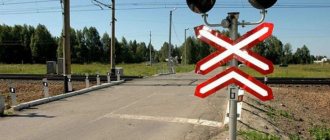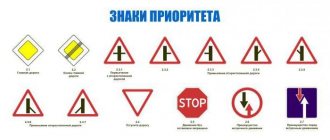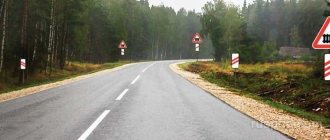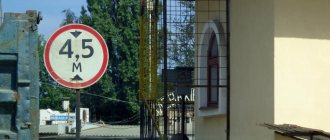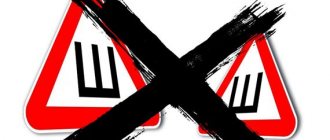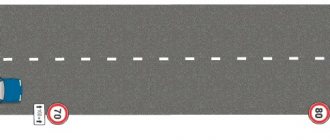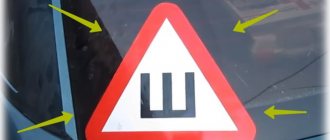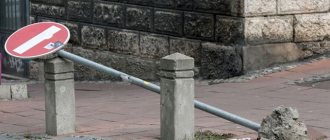These signs warn you that you are approaching:
| 1. | Towards a railway crossing without a barrier. |
| 2. | Towards a railway crossing with a barrier. |
| 3. | To the place of work on the road. |
The main sign “Railway crossing with barrier” outside populated areas is installed at a distance of 150 to 300 m before the crossing, in addition, the same sign is installed again at a distance of at least 50 m before the crossing.
“Approaching railroad crossing” signs provide additional warning that you are approaching a railroad crossing. They are used only outside populated areas.
Approach signs for railway crossings
To safely approach a railway crossing with a barrier, the distance from the warning sign to the intersection with the railway is strictly regulated by law.
It is the installation of a sign that can notify the driver of an upcoming crossing across the railway line.
Roads can be straight or winding; accordingly, the latter can pose a danger to the driver if he is not notified in advance by the appropriate sign.
Even if you take a straight road, there may be poor visibility due to fog, snowstorm or night time.
Therefore, timely information about approaching a railway crossing without a barrier will ensure the safety of all vehicles.
Can you outrun a tractor?
| 1. | No. |
| 2. | Yes. |
| 3. | Yes, if overtaking is completed 100 m before the crossing. |
Overtaking is prohibited at railway crossings and closer than 100 m in front of them. Since the railway crossing is located outside the populated area, the signs “Railway crossing without a barrier” and “Approaching a railway crossing” are installed at a distance of 150-300 m before the crossing. Therefore, you can start overtaking the tractor in this situation if the overtaking is completed 100 m before the crossing.
These signs warn you:
| 1. | About approaching a railway crossing with three tracks. |
| 2. | About the presence of a railway crossing without a barrier in 150-300 m. |
| 3. | About the presence of a railway crossing in 50-100 m. |
In front of you is a sign for a railway crossing without a barrier. The sign “Approaching a railway crossing” with three stripes installed underneath is only an additional warning about approaching the crossing. Outside populated areas, this combination of signs is installed at a distance of 150 to 300 m before the crossing.
Railway signs for the train driver
When you are traveling on a train, of course, you look out the windows with great attention and interest, it is understandable, the landscapes outside the window, unfamiliar cities, stations, towns and villages, the whole country before your eyes in reality, and not on TV. In the summer it’s even better, you can open the upper windows, and in the old German-built carriages (Amendorf) you can open the windows halfway and breathe in fresh air, in general it’s very cool! Let's look from the window at the side of the railway track on the right side and pay attention to the signs installed there, how does the movement of the train change after following these signs and what information do they carry? They carry very important information, especially for the locomotive crew. We will not delve into the intricacies of railway instructions and everything else, but will consider the most significant and noticeable signs. These signs are called signal signs, let's start.
We stood at the station for a long time, the locomotive or locomotive crew changed, another carriage was attached to our train while we were walking along the platform, or, on the contrary, it was uncoupled, or maybe we just stood for more than 20 minutes, it doesn’t really matter, in general the train moved on let's hit the road.
We look out the window and see such a square sign with a red border “NT” fixed on a contact line support or standing separately on a pole, this sign “tells” the driver - “Start braking”, in general the driver is obliged to check the train brakes for efficiency already on the route , but the areas where this check takes place are strictly regulated, so the driver must accelerate the train (usually up to 60 km/h) and perform a braking stage, and here we will see a second sign, exactly the same, but with a black border and the letters “CT” - “End of braking”, in general, the speed of the train from the beginning of braking to its end should drop by 10 km/h, and this sign shows that the brakes must be released, if the speed has dropped by the required amount in the section between these signs, then everything is fine , the driver releases the brakes and the train moves on. If the speed in this section has not decreased, then something is wrong, and the locomotive crew is obliged to act differently, but we will not touch on this.
We drive further and see a square yellow shield, the train begins to slow down, so this is the sign - “Yellow Shield”, it is installed at some distance from the next sign, such a round disk with a black border and a black horizontal stripe in the middle - “The beginning of a dangerous place.” Each stretch has a certain maximum speed, but the railway workers discovered a fault with the track and this section of the stretch must be proceeded at a reduced speed to ensure traffic safety. The locomotive crew receives the appropriate warning forms, which indicate these sections and the speeds along them, and the following signs are installed directly on the tracks - a yellow shield warns the driver that there will be a dangerous place ahead and that it is time to slow down in order to proceed through the dangerous place at a reduced speed, well and the very beginning of this dangerous place will show this round sign with a horizontal black stripe in the middle. But now the dangerous place is over, and we see another sign - “End of the dangerous place”, exactly the same round, bordered with a black border in a circle, but with a black stripe located vertically in the middle, and at a certain distance, having followed the dangerous place, we will see sign - “Green shield”, everything can be followed at the set speed. This very green shield indicates to the driver that the entire train has left a dangerous place, because trains have a certain length, and the driver does not see the last car passing through a dangerous place, which is why this sign is installed. On a passenger train, the driver does not have to wait for the green shield to pass, because a passenger train is much shorter than a freight train, but a freight train driver pulls the train all the way to the green shield.
If the warnings are permanent, then instead of yellow and green shields, discs with the same colors will be installed. So here it is. You can often see the so-called warning signal - the letter “C” and a green stripe below, this sign means that you need to blow a whistle, a sound signal in general, and it is installed in front of tunnels, bridges, crossings, etc. Although it is interpreted as a “whistle,” the sound signal can also be given with a high-volume signal - a typhon.
There are square signs “Gas” and “Oil” with exclamation marks on the left side, their meaning is clear - the intersection of a railway with gas and oil pipelines. In areas electrified with alternating current, signs are installed - “Turn off the current”, “Turn on the current on the electric locomotive”, “Turn on the current on the electric train”, they are installed in front of the neutral inserts (current sections), which the electric locomotive must proceed in a de-energized state. On lines electrified with direct current, signs are installed on current dividers - “Attention - current divider”, “Lower pantograph” and “Raise pantograph”.
Prepare to lower the pantograph - Lower the pantograph - Raise the pantograph
Also, in all electrified areas, when there is a break in the contact network, general temporary signs are installed - “Prepare to lower the pantograph”, “Lower the pantograph” and “Raise the pantograph”. But I won’t describe all these sophisticated “electrified” signs. There are many signal and warning signs, permanent and temporary, but I wrote about the most basic ones, so when you travel on a train, maybe you will remember my works and any sign you see will no longer be incomprehensible to you and you can even show off your railway knowledge to fellow travelers!
Similar
What signs are installed immediately before a railway crossing?
| 1. | Only A. |
| 2. | Only B. |
| 3. | Only in. |
| 4. | A and B. |
Answer
| Sign B “Multi-track railway” is installed closest to the railway crossing. It is placed in front of railway crossings without a barrier on the same support as traffic lights, and in their absence, at a distance of at least 20 m from the nearest rail. |
| Signs A “Railway crossing with a barrier” and “Approaching a railway crossing” are installed only on roads outside populated areas at a distance of at least 50 m from the dangerous area. |
| Signs B “Railway crossing without a barrier” and “Approaching a railway crossing”, respectively, 150-300 m before it. |
The correct answer is Only B.
Railroad crossing rules
Railway tracks are an integral part of the modern infrastructure of our state. Almost every city has a train station, an industrial zone and food warehouses. Trains are involved in the operation of each of these facilities.
For this reason, almost every driver, at least once in his life, had to cross railroad tracks.
But in order not to get hurt when crossing such a dangerous section of the road, it is necessary to strictly follow the rules for crossing railway crossings.
According to clause 15.1 of the traffic rules, crossing railway tracks is possible only at railway crossings.
1. Adjustable railway crossing - a type in which one or more warning structures are installed at the crossing:
- traffic light
- sound alarm
- barrier
- metal shield blocking the path
- duty booth
2. Unregulated railway crossing - a type that does not have any of the above warning methods.
Any controlled crossing over railway tracks is indicated by different road signs depending on whether it has a barrier or not and how far away it is.
Approaching a railway crossing:
- The first sign is installed 150-300 meters from the crossing. At this distance, overtaking is only allowed for cars moving at low speeds.
- The second sign is installed at a distance of 100-200 meters from the danger zone. Overtaking is prohibited from this distance.
- The third sign indicating the approach to the railway crossing is located 50-100 meters from the crossing. In addition to the ban on overtaking, there is a ban on parking of vehicles.
Fines for crossing railway crossings
- attempting to bypass a barrier or overtaking on the opposite side at a railway crossing - a fine of 1,500 rubles;
- stopping at a railway crossing - a fine of 1000 rubles;
- for incorrect passage of a railway crossing in places not designated for crossing - a fine of 1000 rubles or deprivation of a driver's license;
- fine for crossing a railway crossing through a red light - a fine of 1000 rubles or deprivation of rights.
According to clause 15.3 of the traffic rules, crossing the railway track is prohibited when:
- train approaching
- closed barrier
- red traffic light
- prohibiting signal from the duty officer
- traffic jam behind the crossing
Any of these conditions is sufficient to stop the vehicle. In this case, the driver must stop either at the STOP sign or near the stop line. If they are missing, then you need to leave 5 meters to the barrier. If it is absent, the distance to the nearest edge of the rails must be at least 10 meters.
It is better to drive through a railway crossing at the highest possible speed, but taking into account the unevenness of the road, in order to leave the danger zone as soon as possible.
Railroad crossing rules do not recommend driving onto the tracks until the previous vehicle has left the crossing.
This is necessary so that in case of an unforeseen situation you do not have to stop on the railway tracks, thereby further aggravating the situation.
In the event of a malfunction of a barrier, traffic light or alarm system, the duty officer is obliged to independently regulate the movement of vehicles using his hands or red flags.
What signs are installed before a railway crossing? Unequipped crossings are found in areas remote from populated areas. Often at such crossings there is a sign requiring people to stop before crossing the tracks. All rules for calculating distances coincide with those indicated when crossing a controlled crossing.
After braking, you need to make sure that there is no train. This can be done visually, but if there are descents, ascents and turns, it is better to get out of the car and check the approach of the train by ear. It is better to do the same at night and during increased fog. After this, you can continue driving and cross the crossing.
If you are forced to stop at a railroad crossing and the vehicle stalls while crossing the railroad tracks, it is necessary to remove it from the rails as soon as possible.
But before this, the emergency alarm must be turned on, and all passengers, if any, must be disembarked and taken out of the danger zone.
Then you need to contact the attendant and have the vehicle towed with the help of other motorists.
They represent circular movements of the hands with a red flag or any other red material. At night, a lantern is used instead of a cloth. If there are no assistants, you should use Morse code and start broadcasting the letter “B”.
When crossing railway crossings, you should always remember the full extent of the possible injury hazard of this event.
A train weighs many times more than a car; a braking distance of several meters is clearly not enough for it.
Although the legislation of our country is doing its best to reduce the number of accidents in any situation, personal care and responsibility have never failed anyone.
https://www.youtube.com/watch?v=ytadvertiseru
A railroad crossing is the intersection of a railroad track with a roadway. Crossings can be regulated and unregulated, single-track and multi-track, with and without a barrier.
Driver inattention and disregard of the rules when crossing a crossing entails quite disastrous consequences. Before breaking traffic rules, compare the weight of your car and the weight of the train.
1. Adjustable - this type is equipped with special designs and sound alerts.
At such a crossing, as a rule, semaphores, markings, barriers or special metal shields are installed, which rise when the train approaches, blocking the passage of the motorist.
There must also be an attendant on duty who regulates traffic and gives special signals.
2. Uncontrolled railway crossings do not have warning signs or signal alerts and are not controlled by a person on duty. Traffic in these areas is carried out in accordance with traffic regulations.
- - reversing;
- — turning around directly at the crossing;
- - crossing a railway crossing with a lowered or closing barrier, as well as any other device blocking the passage;
- — continuation of movement when there is an active sound warning or an alternately flashing traffic light signal;
- — a train, locomotive or handcar appeared within sight;
- — the person on duty at the crossing makes stopping signals (a baton raised above his head, signals with a lantern or flag, arms extended to the sides);
- — after crossing the tracks, a traffic jam is visible, which may lead to a forced stop at the crossing.
- The white-lunar traffic light signal is not prohibitive.
| 1. | Both did not violate. |
| 2. | Both violated. |
| 3. | Only the driver of car B. |
| 4. | Only the driver of car A. |
Both drivers violated the Rules, since parking is prohibited within 50 m on either side of railway crossings.
Which driver violated the parking rules?
| 1. | Both did not violate. |
| 2. | Both violated. |
| 3. | Only the driver of car B. |
| 4. | Only the driver of car A. |
Both drivers violated the Rules, since parking is prohibited within 50 m on either side of railway crossings.
Is such a maneuver allowed?
| 1. | No. |
| 2. | Yes, if there are no oncoming vehicles. |
| 3. | Yes, if the distance between the barrier and a stopped truck is 6 m. |
The driver of the truck stopped in accordance with the requirements of the Rules - no closer than 5 meters from the barrier, and passing vehicles standing in front of the crossing into oncoming traffic is prohibited.

